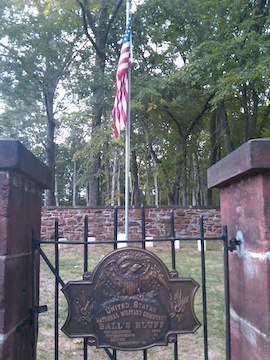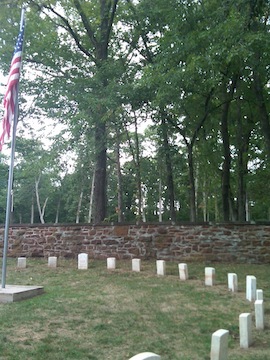Ball’s Bluff National Cemetery
 Way back in 2011, I had the privilege to walk the Ball’s Bluff battlefield with historian Jim Morgan and talk about his book on the battle, A Little Short On Boats, just then released. (You can read that interview here and a review of the book here.)
Way back in 2011, I had the privilege to walk the Ball’s Bluff battlefield with historian Jim Morgan and talk about his book on the battle, A Little Short On Boats, just then released. (You can read that interview here and a review of the book here.)
During that conversation, Jim also told me about Ball’s Bluff National Cemetery, located on the eastern edge of the cleared portion of the battlefield. With 54 soldiers buried in 25 graves, it’s the third-smallest national cemetery. “There’s one’s at the Hampton, Virginia, Virginia, medical center that has 22 graves,” Jim told me. “In D.C., in Rock Creek Park near Fort Stevens—it’s called Battleground National Cemetery—there’re 41 guys there. I’m not sure, in terms of physical area. This is 48-feet square.”
I set aside the portions of our conversation about the cemetery with the intent to do a story, separate from my interview about his book, about the cemetery. Alas, as innkeeper Barliman Butterbur frequently said, “One thing drives out another,” and I never got around to the cemetery piece.
Until now.
Today’s the anniversary of the battle of Ball’s Bluff. In commemoration of the event, here’s what Jim had to tell me about Ball’s Bluff National Cemetery, in Jim’s words:
 This battlefield would have been completely forgotten if it wasn’t for the fact that there was cemetery here. The cemetery got established right at the end of the war. It was opened, if you want to call it that—officially recognized as a cemetery—in December of 1865.
This battlefield would have been completely forgotten if it wasn’t for the fact that there was cemetery here. The cemetery got established right at the end of the war. It was opened, if you want to call it that—officially recognized as a cemetery—in December of 1865.
They found some remains here and buried them. So this becomes an official national cemetery.
The first burials took place on a reverse slope of the field. We know that there were three long shallow graves. But they weren’t serious burials—just some dirt thrown over them. We know this because within twenty-fours hours, it had rained and washed all the dirt away. So, literally within twenty-four hours after these guys were buried, they’re exposed to the elements. There was a Confederate war correspondent who was here a week after. Very graphic. He talks about a drove of pigs feasting on the corpses of Union dead.
I tell people about that because there’s a certain shock value to that. It makes them think.
After 1862, the Confederates leave this area, and that’s it. These bodies just lay here, and they get scattered all over. Pigs and dogs and whatever. Rain washes ‘em all over.
When I get people in here, I point out all the unknowns—point out that even though there are 25 graves here, there are actually 54 individuals represented in this cemetery, and 53 of them are just partial remains.
You’ve got Private James Allen up there [Co. H, 15th MA]. As far as we know, he’s intact. Certainly he’s identified. Been trying to get some kind of ground-penetrating radar in here to see if his whole skeleton is there.
We know from a letter that there are small boxes buried here, and in each box are random bones and identified only to the extent that they know ‘this leg bone does not belong to this skull,’ but there’re no names.
And that’s what they found. They’re like this because that’s what they found in 1865 when they came back and began gathering up, wandering around the woods. They found all these human bones. Obviously these are the guys who were killed at Ball’s Bluff, but they’re scattered, partial remains and there’s nothing else you can do with them except what they did.
It’s sad. You think about all the people back in Boston or wherever, they’ll never have any remains they can grieve over.
There are a couple stories of photos being found, and working their way back to someplace back up north. In one instance, a photo was displayed in a shop in Boston with a sign underneath. It was a picture of a soldier, with a sign underneath that said, basically, ‘Can you identify this soldier?’ And a woman from Boston recognized it, and it was her husband, and that’s how he found out for sure he had been killed at Ball’s Bluff.
The army was going to close this cemetery several times because it is so far off the beaten path. In 1943, ’47, and ’57. The army wanted to close this and move the bodies, I think, to Culpepper and bury them at the national cemetery there. And they offered it to the Park Service each time and the Park Service turned it down. And so the army was just going to abandon the property, take the bodies and put them someplace else—but you had all this local uproar. So they said, ‘No, we can’t do it.’ There were veterans groups that got involved. A senator from Oregon got involved—because Edward Baker [a Union officer killed at the battle] was a senator from Oregon—and he basically forced the army to keep this place open.
It’s another 25 years after that before the Northern Virginia Regional Parks Authority takes over the battlefield. It took time….
All of the Confederates killed at the battle were accounted for. We know there are no Confederates mistakenly buried here. These are all Union guys. The guys from the 8th Virginia, which was the local Loudon County unit, most of them were just taken to their nearby home churchyard cemeteries and buried there. A lot of the Mississippi guys are buried in Leesburg, which is called the Union Cemetery, which throws people off. It has nothing to do with the war. In the 1850s, several churches got together and formed a ‘union’ to buy property and use it as a joint cemetery, so that became known as the Leesburg Union Cemetery. There’s one in Lovesttville, too. That one’s called the Lovettsville Union Cemetery. It throws people off: ‘Why are all the Confederates buried in the union cemetery?’ Well, that’s why.
A lot of Mississippians are buried there. There’s a big Mississippi monument. The state of Mississippi paid for a monument. A lot of them are unknown—or maybe not so much unknown as the graves are unmarked. A few of the casualties, depending on whether your parents or your wife could afford it, I suppose, were shipped back home for burial. But there’re quite a few of them in the Union cemetery.

Thanks for this highly illuminating post. As we know, Ball’s Bluff was where a young officer in the 20th Massachusetts received the first of three serious wounds during the War. Lt. Oliver Wendell Holmes, Jr. took one in the chest at this fight iIRC.
Jim Morgan is a splendid fellow.